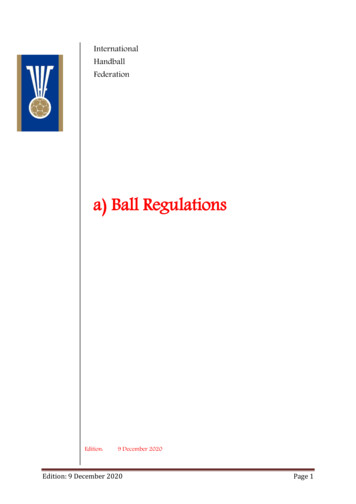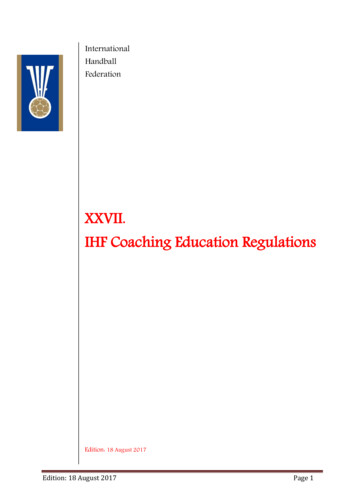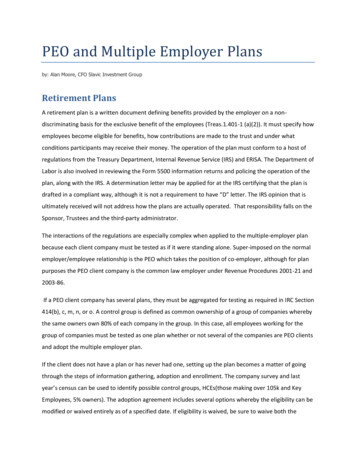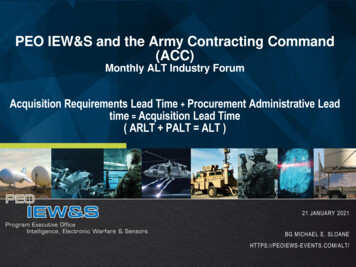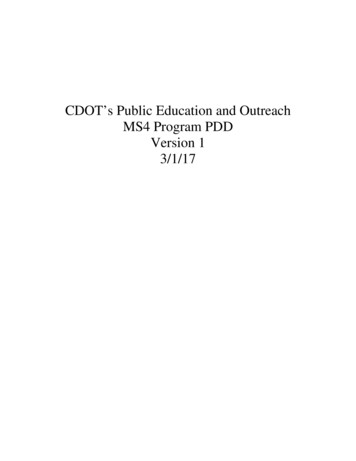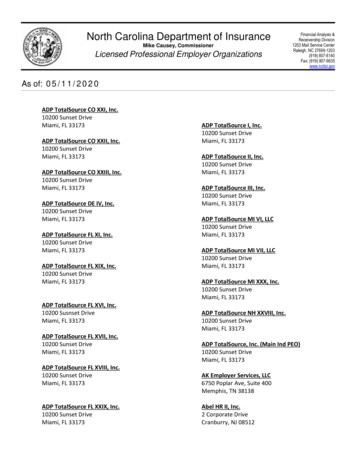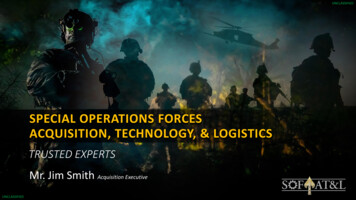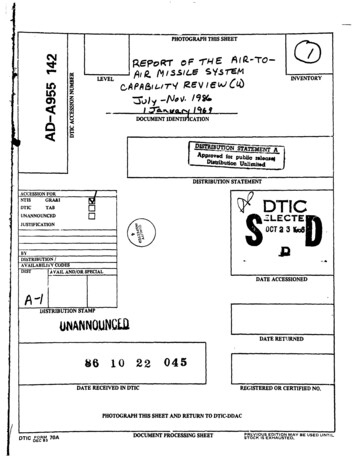
Transcription
PHOTOGRAPH THIS EIHF6VletAC4)DOCUMENT IDENTIFICATION.W.ý- rNSTATEMENTAApproved for Pubiclo"logq-sDISTRIBUTION STATEMENTTIACCESSION FORNTISGRAMDTICTABDTICUNANNOUNCEDJUSTIFICATIONI'- DISTRIBUTIONB .,,DIST[AVAILAND/ORCODESAVAILABILIfYZLECTEOCT 23UO8SPECIAL ,DT'CESOEDAEACCESSIONEDDISTRIBUTION STAMPUUANNOUN.L.DATE861022RETURNED045DATE RECEIVED IN DTICREGISTERED OR CERTIFIED NO.PHOTOGRAPH THIS SHEET AND RETURN TO DTIC-DDACDOCUIMENT PROCESSING SHEETDTIC370APREVIOUS EDITION MAAY BE USED UNTILSTOCK IS EXHAUSTED.
0,IREPORTOF THEAIR-TO-AIR MISSILE SYSTEMCAPABILITY REVIEW (U)JULY - NOVEMBER 196"R.UtTECHNICAL.Ll'NAVAL AIR Y5TTO'yY NDNAVAL AIR SY STEMS COMMAND*1 -
REPORT OF"cTHEAIR-TO-AIR MISSILE SYSTEMCAPABILITY REVIEW (U)JULY-NOVEMBER 1968RETURN TONAVAL AIR SYSTEMS CO,,Ifl oAf\P-1 JANUARY 1969NAVAL AIR SYSTEMS COMMAND/
MASTER INDEXPageABSTRACT.II.IMPLEMEhTING MESSAGE.III.APPROACH AND METHODOLOGY .IV.SUM4ARY REPORT.A.3.5. . .Industry2. . .Fleet Support Organizations.Squadron/Shipboard Performance.Airborne Performance.Rework Program .Overvi-w . . . . . . . . .6.Policy. . . . .Management .Production . . . . . . . . . . .Performance vs. Design .Maintenance and Test .Aircrew TrainingPersonnel/Training (Other than Aircrews) . . .Support . . . . . . . . . . . .LogisticDocumentation .* .is0. .3.4.5.6.7.8.10.11.12.1.3.17171819. .1.17.2.Major Conclusions and Recommendations .S9. .1.4.5.B.General Findings . .3.1. . . . . . . . . . . . . . . . . . . . . . . .I.2323.24.i4. Evaluation by FMSAE)G . .C.Funding Estimates . .D.Proposed Action Matrix.Report of Task Team One . .25273113538.4o43. . . . . . . .Surveillance . . . . .Inspection . . . . . . . . . . . . . . . . . . . . . .Safety . . . . . . . . .Rework . . . . . . . . . . . . . .202223. .444546474850.51AppendicesI.II.SiiiL4Report of Task TeamTr"wo. , .I-II-1
mu-rMASTER !NDEX (continued)PageAppendices (continued)III.IV.V.VI.Report of Task Team Three.II-1Report of Task Team Four .Report of Task Team FiveIV-1.FMSAEG Support of Air-to-Air Missile System Support. . . . . . . . .Requirements . . .ivV-1VI-1
,-,REPORTOF THEAIR-TO-AIR MISSILE SYSTEMCAPABILITY REVIEW (U)JULY-NOVEMBER 1968SECTION INAVAL AIR SYSTEMS COMMANDI0 tti;4244UMtSS
SECTION I - ABSTRACTA. Almost 600 air-to-air missiles have been fired by Navy and Air Forcepilots in about 560 hostile engagements in Southeast Asia between 17 June1965 and 17 September 1968 (date of last hostile engagement)Performancein combat indicates a probability of achieving about one kill. for everyten firing attempts in any engagement where air-to--air missiles are employed in an environment similar to that in Southeast Asia.B.Pursuant to CNO message DTG 241506Z July 1968, during the period8 August-S November 1968, a five member review team, directed by CaptainFrank W. Ault, TUSN, 165597/1510, NAVAIRSYSCOM, (AIR-001), conducted a-nin r- owf the entire process by which the Navy's Air-to-Air MissileSystems are acquired and employed in order to identify those areas whereimprovements can and should be made.C.Systems included:1.P8 H/J2.FhB/AER0-lAF4J/AWG-10AIM 7D/AIM 7E/AIM 7E-2/AIM 7F (SPARROW)AIM 9B/AIM 9C/AIM 9D/AIM 9D(SEAM) (SIDEWINDER)3.4.5.D. In assessing performance to date and exploring the ways and means ofeffecting future performance improvements, the review addressed air-to-airmissile systems in each of five discrete stages of their life cycles, ranging from original design and manufacture thro.gh repair and rework.Reviewobject'.ves were pursued by the address of five basic questions, each keyedto a specific area of 4 nquiry:1.Is industry delivering to the Navy a high quality product,and built to specifications?designed2.Are Fleet support organizations delivering a high quality productto the CVA's and to the forward area sites ashore?3.Do shipboard and squadron organizations (afloat and ashore) launchan optimally ready combat aircraft-missile system?4.Does the coribat aircrew fully understand and exploit the capabilities of the aircraft-missile system? (Corollary question: Is the aircraftmissile system properly designed and configured for the air-to-air mission?)5. Is the air-to-air missile system (aircra't/fire control system/missile) repair and rework program returning a quality product to theFleet?JM
E. The review indicates that numerous design, procedural, and organizational changes can and should be made. Some are immediately feasible andsubject to early implementation. Others require time-phasing or requireresolution of certain policy, economic, technical, and/or operationalconsiderations. In all cases, vigorous follow-up and follow-through willbe required if requisite improvements to current capabilities are to bereali zed.b2
REPORT-OF THEAIR.TO-AIR MISSILE SYSTEMCAPABILITY REVIEW (U)JULY-NOVEMBER 1968SECfON 11NAVAL AIR SYSTEMS COMMANDOro -Oft mr-r,P
-*man,-mmNAV LOPKwv POAMaltO-M(my(when1S- 61)Pe.ONE9 .XT.ATI0 I7RELZArEO SYWISAI."IA"P-M UP OCT)ATE/TkE G'4PAU7CEKOff[I,IR 2415o6z JuL SIX EDAC4IAVMISCEN JGUC0MNAWPNCE!x 72LAKECOME'rqMJLTCOMREADATKCARAIRWIw, 4CO1MVSTFOBCOMNVAMIRSSCOMCOHREADATKCARAIRWING 12CGFM!PACCGFMFLANTCONFIDEMTIALAir-to-Air Miqsnle Capability (U)Combat performance ir Southeast Asia continues tc indicate1. (C)a need for an in-depth exsaination of tne entire prucess by whichAir-to-Air ýAssile systems ire acquired and employad.-. (C) Captain Frank W. Ault 165597/i 10 'U.S. Navy NAVAERSYSCOMCode 001, has been directed to conduct such a review in ,jrder toidentify an3 and all areas where improvements can and should bemade. In addition to inputs from industry he will require support"BTRIOUTIO "IIpAOt ON(- ONLY) !j' t L.r½IO,/TIMEYgROUPiGCT)S241506Z JUL 68*S-"-uCTIO"OP CLA84IPIGO W&*SOSSZ IN WK9LE On IN PAN't to PoftIMITCOMWWA1AirgOpCHECKEO gYrOR/TOOOAMR.MENCIPTWITH pSISWiSSION Or IS-Mee.fildI.)7-11am
OPMVFW v 1AGIE11AD ICTE/EXvT. -NfYPRONIGROUPOuPWC)C"tISCN(ISRCICEsByOMW'ONAaby those Navy and Marine Cr'vpzi conmmnds and activities involvedwith Air-to-Air missile systems acquisition and/or employment.(C) The majority of the review will be conducted throughvisits to cognizan t commands and activities by Captain Ault and/orone to six key team members and by the assignment and execution ofspecial tasks as mutually agreed and approved by appiropriate authority.As an early step, a Fspecial, one-time Air-to-Air missile systemssymposium is tentatively planned to be heid at the NAVMTSCEN Pt.Mugu 19-23 August 1968 during which a sub.OMuitttee approach will beemployed to address review objectives as then defined and toIdenitify other relevant areas f'or further inquiry. Addit ional Information oilthis symposium will te promulgated prior to I August. Afirm itinerary of team member visits will be promulgated earliest.3.4. (C) Your cooperation and assistance in this review effort willaid in the orderly delineation of probler. aresa and the tinelyformulation of a plan to achieve a substanitial improvement, in combatcapabilities of our air-to-air missile systems.Gp 4DIN TNIEUT ION IIPAGE 0ONE ONLY)JUL 6821&150609.NBFU4OVPF@ -ASSN119IM4jjjjjsIN jillj9e jPAIsj&*,c.w1aT"tpas.ueetWNofille1A '44YPAGavPA09IS-NGl.I.)oICa
REPORTOF THEAIR-TO-AIR MISSILE SYSTEMCAPABILITY REVIEW (U)JULY-NOVEMBER 1968SECTION IIINAVAL AIR SYqTiEMS CtOMMANDurn-.,
METHODOLOGYSECTION III- APPROACH ANDA. Since the commencement of hostilities in Viet Nam in 1965, both theNavy and Air Force have conducted several evaluations of air-to-air missileperformance in combat operations.Despite a plethora of recommendationsdirected to improvements in performance - a number of which consistentlyrecur in consecutive reports - combat kills per numbers of missiles expended remain below expected or desired levels.B.The scope of previous reviews/evaluations generally has been limited toexamination of discrete areas of interest/activity such as:1.Test and evaluation.a.CONTJS (e.g.Navy's ComOpTevFor Projects or USAF's "SPARROWb.Forward Area (WestPac)SHOOT")2.Training (e.g.firings).(e.g. USAF's "COMBAT SAGE".)FMSAEG evaluations of Navy/Marine Corr; training3. Combat performance of specific units over specific periods of time.(e.g. Navy's "Walker Report" of 3 July 196d covering combat performance ofthe USS A!MERICA (CvA66, and USS ENTERPRISE (CVAN-65) during May and June1968).4.Summary analyses of U.S.WSEG's "RED BARON" Project).combat performance in Southeast Asia (e.g.5.Production evaluation (e.g. Production Monitoring Tests atNavMisCen Pt. Mugu or FMSAEG evaluations of missile rework programs at NAPFAlameda and NAPF Norfolk).None of these addressed concurrently the aircraft-missile fire controlmissile system across the complete spectrum of design, acquisition, operational, and logistic processes/procedures which determine its characteristius and/or influence its performance.C. Accordingly, this review was undertaken with two basic premises firmlyin the forefront:1.There was a need to examine concurrently the complete spectrum ofinfluences on weapon system characteristics and performance in order toidentify those primarily reflected in combat results while assessing theneed for, and practicability of, changes/modifications.2.Improvement in the combat capabilities demonstrated to date manifestly could not be achieved merely by doing better those things now beingMaltrr
done.The need for new 'pproachesand innovations appeared self-evident,considering the continuing inability to achieve desired results through theattempted implementation of recurring recommendations.D. An initial step was the formulation of a review plan prescribing areasfor review and factors to be considered in each. As can be seen in enclosure (i) to this Section, the plan encompassed five major areas of inquiry,each addressing those functions involved during the successive stages comprising the life cycle of the weapons system. Review objectives and scopewere expressed in terms of five basic questions:1. Is industry delivering to the Navy a high. ,alityOroductj designedDe.i.g-i, Development,(Functions/Fa".tors.and built to specifications?Production).2.Are Fleet support organizations delivering a high quality productto the CVA's and to the forward area sites ashore? (Functions/Factors:Storage Maintenance, Surveillance, Test, Repair, Transfer, Issue, LogisticSupport 5 .3.Do shipboard and squadron organizations (afloat and ashore) launchan optimally reiyaircraft-missile s2stem? (Functions/Factors:Storage,Maintenance, Assembly, Test, Repair, Handling, Loading).4. Does the combat airnrew fully understand and exploit the capabilities of the aircraft-missile system?a.(corollary question) Is the aircraft-missile s, stem properlydesigned and configured for the air-to-air mission?Procedures,(Functions/Factors:Training, Readiness,Human Engineering, Systems Performance).Doctrine, Tactics,5.Is the air-to-air missile systems repair and rework program returning a quality product to the Fleet? (Functions/Factors:Reyair vs Rework,Engineering and Logistic Support, Funding, Quality Assurance).E.The next step involved theand di.'ect the review effort inThe fillowing were selected oncation in the particular areasience, and duty n of five Task Leaders to coordinateeach of the major areas of enclosure (1).the basis of reputation as well as qualifias a result of professional training, exper-Mr. B. W. Hays, NWC China LakeMr. W. W. West, NWC Corona LabCdr. B. H. Gilpin, USN, NavMisCen P'. MuguCapt. M. H. Gorder, USN, OpNav (Op 561E)Mr. 0. C. Robbins, NavAirSysComRepPacA)U
These five Task Leaders, plus the Review Director, formed the Review Team.Task Teams were formed by Task Leaders to woir in each area and were referred -o by Task Team number (viz. Task Team One, Task Team Two, etc.)F.The firstmeeting of the Review Team was held at the Naval Missile Center, Pt. Mugu on 8 August 1968.It had been determined previously that theaircraft-missile systems involved in the review were:1.F8H/J2.F4B/AERO1AF4J/AWG1O3.4.5.AIM 7D/E/E2/F 'SPARROW)AIM9B/C/D/D(SEAm) (SIDEWINDER)The review effort involved three basic phases to be addressed morp or lessconcurrently:the collection of data, the collation of that data, and theevaluation of the data in order to generate conclusions and recommendationstherefrom.It was agreed that, within the constraints of time and manpoweravailable, conclusions and recommendations would be tran:lated to proposals, plans, schedules, and funding wherever practicable.This latter stepwas deemed necessary in order to particularize terms of reference and tocatalyze the impetus it was felt would be needed for early, aggressive ac-.tion in some instances.Recognizing that the Review Team had no executiveauthority, it was agreed, at the outset, that ideas of special merit ortimeliness would be relayed, as generated, to appropriate authority by theReview Director for consideration in advance of the Team's final report.G.Methodology essayed involved the following:1.Data Collectiona.b.c.d.L.Briefings/InterviewsReview of existing pertinent literature/reports.Field VisitsAir-to-Air Missile System SymposiumData Collationa.Identification of factor(s) or function(s)review area.b.involved ineachOrganization of Task Teams within each review area.c.Task Team development of cause and effect consi.derationslated to factors/functions involved.3.Data Evaluation and Generation of Recommendationsa.PTask Team evaluation and recommendations'IIWs IINCLA las re-
b.c.Review Team coordination and reviewReview Director approval and consolidationH.As st ated previously, the foregoing efforts moved forward more or lessconcurrenvr.ly.Since the Review Director had been a member of the team in-volved with the 28 June-3 July 1968 air-to-air missile review in the USSAMERICA and USS ENTERPRISE, the in-depth review commenced essentially atthat point. Prior to the first meeting of the Review Team a field visithad already been made (by the Review Director and the Task Four Leader) tothose CONUS Fleet Commands on both coasts concerned with air-to-air missiletraining. This visit set the pattern for other visits. (viz. a visit bythe Review Director to each of the stations/commands/plants/etc. associatedwith air-to-air missilery, accompanied, in each case, by the Task TeamLeader in the particular area involved (i.e., Task Team One 'eader forIndustry, Task Team Three and Four Leaders for CVA's, Task Team Two Leaderfor Weapon Stations, etc.)).Such visits were followed up, where appropriate or necessary, by Task Team Leaders whose Task Teams conducted indepth, on-site reviews and analyses. A summation of the sites visited during the period 30 July-1 November appears in enclosure (2) to this Section.The oportilnity to observe, interrogate, compare, discuss, and debate inthe actual operating environment was an indispensible element of the datafinding/collation process and provided, as well, the perspective essentialto meaningful evaluation.Briefings, interviews, and reviews of existing documentation/reportsproceeded concurrently with other review efforts as the Review Teamattacked the problem of evaluating past performance, progrm actions, andproposals while remaining abreast of current developments in an extremelydynamic environment.An air-to-air missile system symposium at the Naval Missile Center, Pt.Mugu, during the period 19-23 August brought together over 200 attendeesrepresenting the complete spectrum of interest and/or direct participationin all phases of air-to-air missilery: Industry, Fleet, Shore Establishment, and Marine Corps. The primary objective of the symposium was toidentify problems and reach L ncurrence on their definition. No real attempt was made to solve probl. s then identified, although recommendationsfor solutions frequently evolved as a natural consequence of symposium',oceediuigs. Primarily, however, the symposium filled out the review ma-Vices for the Task Leaders whose chore it then became to analyze andevaluate the slightly over 200 problems identified and to develop and refine problem solutions.Shortly after the symposium, the three principal contractors - McDonnell. Westinghouse, and Raytheon - formed a coordinated management andengineering team to develop and refine industry's role in solutions to theproblems involved and to advise and assist the Review Team, as required.This team - a notably dedicated and objective group - functioned mosteffectively throughout the review period.vflet, 'Other contractors involved, as-
well, cooperated unreservedly so that required inputs from industry werereadily available at all times.Task teams worked individually - with occasional phone or personal contacts as required for coordination or consolidation of functions - until8 October.At that point a meeting of the Review Team was held at theNaval Missile Center Pt. Mugu to check progress, to verify that all problemareas were being covered, and to check, finally, for duplication of effortor improper emphasis.Only minor adjustments were required and Task Teamsproceeded on a schedule directed to review wrap-up in early November.rDuring the period 4-8 November the Review Team held its final sessionsat the Naval Missile Center, Pt. Mugu for puirposes of coordination and review )f the findings o.' each of the five Task Teams.The industry tcampreviously mencionad ,:as available at Pt. Mugu throughout the week in aconsultant capacity and provided a final up-date on somne of the technicaland fiscal data.I.A very real problem for the Review Team throughout the period of itsefforts was the difficulty in remaining abreast of the almost daily changesto programs during the course of the review.For this reason, an attemptwas made to tailor conclusions and recommendations to fit basic problemsolutions rather than to produce detailed, technical, engineering, andfiscal treatises.3J. As a final note, the Review Team could have had no greater incentive topress its efforts to conclusion than by observing that between the firstmeeting of the Team (on 8 August) and the last (on 8 N vemb r) the Navyfired an additional 12 SPARROWS (AIM7E's) and l SIDEWINDERS (AIM9D's) incombat with a net yield of 2 MIG kills: both to SIDEWINDER's.Enclosure (1?:Enclosure (2):Review PlanVisits:30 July1ul-1 November 1968
ILII.Question1. Is industry delivering to the Navy a high quality product, designed and built to specifications?A. Areas of Inquiry1.Contracting - Productiona.b.Philosophy of contrLctsN PerformanceSpecifications (Navy Design)Cczt considerations(1) Fixed price vs. cost plus(a) Developl.ent(b) Prototype productl.on(c) Productionc.2.Design and Developmenta. Requirements and Specificrtionsb. Goals vs achievementsc. Deviationsd.3.(d) Training(2) Contract ManagementResponsibility - Overall Program ManagementContractor - Navy interfaceProductiona. Performanceb. Quality Assurancec. Factory Acceptance Tests (by Industry)1) CriteriaProceduresValiditySpecification responsibilityd. Production Evaluation Tests (by Navy)Criter:,aNl2ProceduresValidity(4) Specification responsibilitye. Government monitoringCorollary/Related Considerations1. Systems Integration, Checkout, and Test2. Facilities3. Personnel: Availability, Training, and Experience4. Documentation/Data Maintenance5. Configuration Control6. Impact of Modification Programs - Management Control7.Feedback - Fleet; Weapon Facilities, etc.8. Waivers, Deviations, and Material Review Board (MRB) Actions9. Vendor Qualification(3)B.ENCLOSURE (i)L .NB. "mAI,. . .LAM&.
II.10.Schedulcs, Funding, and penalty provisions11.12.15.14.Supervision and ManagementDOD - Industry InterfacesProcurement Regulations and ProceduresReliability of ProductQuestion1.Are Fleet support organizations delivering a high qualityproduct to the CVA's and to the forward area sites ashore?A. Areas of Inquiry1.2.RFI Assemblya.Procedures(i) Where developed(2) Coordination and follow-upb. Standardizationc.Quality Assuranced.Inspection/AcceptanceLogistic Pipelinea.Ashore(1) Transfer(2) StorageSurveillanceý35)) Test, Maintenance,and Repair(5) Quality Assurance(6) Issueb.Afloat7Wransfer(2) Storage( Surveillance(4) Test, Maintenance,and RepairW5Quality Assurance6) IssueB. Corollary/Related Considerations1. Systems Integration, Checkout, and Test2. Training5. Documentation4. Safety5. Impact of Modification Programs6. Reliability7. Lifetime and Cycle Specifics8. Packing, Shipping, and Handling9.10.11.12.Si'porta. Partsb. Test Equipment/Calibrationc. Personneld. FacilitiesStandardizationInspection and EvaluationSupervision and Managementpim-k.
13.14.15.0-Policy directionStockpile to target sequenceTYCOM and NASC/NOSC/NAVSHIPS interfaces for logistics flowand maintenance management111. QuestionDo shipboard and squadron organizations (afloat and ashore)launch an optimally ready combat airzraft-missile system?A. Areas of Incquiry (CVA and Naval/Marine Corip: Air Station)1. Strikedown and StorageMaintenance, Test, and RepairM.3. Assembly4. Handling5. LoadingB. Corollary/Related Considerations1. Systems Integration, Checkout, and Test2. Test Philosophy3. Quality Assurance4. Inspection and Evaluation5. Lifetime and Cycle SpecificsSafety (HERO, etc.)6.Trdining7.a. Formal (Schools, etc.)b. OJTc. Drills8. Documentationa. Maintenance, Test, and Repairb. Training and Otherc. Check-off Listsd. Records and reportsSupport9.1.a.10.11.12.13.14.15.16.17.Par aEquipment/Calibrationb. ;.J ing and Loading Equipmentc.P sonnel (Tech. reps., etc.)d. .e. FacilitiesTools and Other Auxiliary Equipmentf.StandardizationElectromagnetic CompatibilityImpact of Modification ProgramsDesign DeficienciesGupervision and ManagementStockpile to target sequenceManagement of assetsa. Materialb. PersonnelShipboard maintenance and supply systems*WSW12)
IV.Questions1. Does the combat aircrew fully understand and exploit the capabilities of the aircraft-missile system?2. Is the aircraft-missile system properly designed and configuredfor tl'e air-to-air mission?A. Areas of Inquiry1. Training and Readinessa. Pilots/RIO's(;) Ground(2)Air*b. Grourd/Deck Crewsc. Material Readinessd. Facilities and SejV.ces2. Doctrinea. NATOP'b. Squadronc. Air Wingd. Rules of EngagementTactics and P'ocedures3.a. Pre-flight checksb. In-flight checks/proceduresc. Firing envelopes4. Human Engineeringa. Switchologyb. Cockpit configuration/instramentation5. System Performancea. Illumination Requirementsb. Dead Timec. Maneuvering Restrictionsd. Firing Envelopese. CountermeasuresElectromagnetic Compatibilityf.6.Training Target Systems/Aidsa. Availabilityb. Adequacy"c. PerformanceB. Corollary Considerations:1. Systems Integration, Checkout, and Test2. Inspection and EvaluationDocumentation3.4. Safety5. Impact of Modification Programs6. Mission/Performance Records7. Standardization/Cross Fertilization8. Design Deficiencies9. Syllabus Requisites vs. Tine Available10. Fighter-bomber vs. Fighter, only employment11. Configuration12. LeadershipAndI- .L'-.
13.14.15.16.V.ExperienceReliability and OperabilityAssets ManagementStockpile to Target SequenceQuestion1. Is the air-to-air missile system (missiles and aircraft) repair and rework program .-eturning a quality product to theFleet?A. Areas of Inquiry1. Repair Progr aa.Criteria - component lifetimeb.Procedures adequacy - Publicatiun adequacySupportM(lPartsc.2.(2) Test Equipment/Calibration(3) Tools(4) Personnela Availabilityb Skills and Training(5) Facilitiesd. Work Load (Include Air Force)e. Quality Assurance (Verification of product process andparts quality)f.System Integration, Checkout, and Testg. Issueh. Acceptance Testsi.ManagementJ.SafetyRework Programa. Criteria(1) Component lifet 4 ie (replacement) specifics, partsqualityb. Proceduresc. Support( 1l Parts(2) Tools(3) Test Equipment/Calibration(4) Personnela Availabilityb Skills and Training(5) facilitiesd. Work Loade. Quality Assurancef. Systenmg Integration, Checkout, and Testg.Issueh. Acceptance Testsi. ManagementJ.Safety147
B.Corollary Considerations1. Training2.Dccumentation3.Safety4. Impact of Modification Programs5.Standardization6.Design Deficiencies7.Lifetime and Cycle Specifics8. Schedules and Funding9.Reliability of product - components and system10. Stockpile to target sequence11. Engineering support by other activities12.Records and reports13.Checkout of modification programs14.Comparison of rework - military vs contractor1Sm41
VISTS: 3JULY-INOVEMER 1968Type CommandersCVA's (all deployed)NAS's (Cont'd)ComNavAi ,antComNavAi PIDCORAL SEAAIMIRCACONSTELLATIONCecil FieldJaclksonvill eKey WestCubi Pt.ComFairsN o r f ol kJacksonvilleNARF's- - -AlamedaKey WestNAVAISYSCOMREPSCaribbedanAlamied aMiramnarnCherryLantPacRangesWeapon Sta.-.OP1RAFWRConcordSeal BeachFallbrookYorktownNAD CraneIndiau *fadCVW'.s/RCVW'sNorth IslandNorfolkPointOther Fit Corns.CincPacFltCTF 77CornS ixthFlt*ComCarDiv 1ComCarDiv 2%omCarDiv 3ComCarDiv 7AllN'avMag F-ibicLabs/C-entersIndustryTech. Tra. Comds.CNATECHTRAChina LakeCoronaPt. GRUCONTTCMemphisCONTCC JacksonvilleMarCorpsLing Temco VoughtAeroj etRocketdyneOTHERHughesThird MAWMCAS El ToroMCAS YumaSecond MAWDe pCorfairWestPacDeF6400 Test Sq. (USAF)TSFVF CAVýFI3VC8NAS's-6MCAS BeaufortMCAS Cherry Pt.AlamedaMiramarOceane*Visit to Sixth Fleet by Special NAVAIRSYSCOM/Industry/AirLantTeamReporting to ReviewSV.Director.ENCLOSURE (2)16 .o6 v,.& A)
i-KIASUfflI1I;REPORTOF THEAIR-TO-AIR MISSILE SYSTEM*CAPABILITY RUVIEW (U)JULY-NOVEMBER 1968SECTION IVNAVAL AIR SYSTEMS COMMANDj*I iu cUCLAESF
SECTION IV SUMM&RY REPORTA.General FindingsThere is always a hope, in undertaking a review of this nature, thatthere will be uncovered a few major discrepancies sc crucial to systemsperformance that there is littlequestion that corrective action willachieve, at once, a readily measurable, quantum improvement in rformanceand capabilities.Such was not to be the case, however, and as the reviewproceeded, it became clear that the road to improvement lay through a virtual jungle of problems:some readily and easily solvable; others requiring more funds, more time, greater effort and sustained perseverance andfollow-through.In sub-paragraph B, which follc'4s, conclusions and recommendations aresub-divided into major functional categories.As a preface to that presentation, the following overview of the findings in each of the areas ofreview activity should provide a better appreciation of the magnitude andscope of the coordinated program which the Navy must prosecute if desiredimprovements in current combat capabilities of air-to-air missile systemsare to be realized:1.IndustryOne of the basic tenets of present day contracting philosophy isthat "fixed price" typet; of development contracts result in savings to theGovernment as compared to "cost plus" types.Despite bonus and penaltyclauses, and other contractual provisionb, history shows that a developmentprogram gen.erally costs tne Government whatever the costs actually are:ifnot in dollars (as is usually the case), then in time, or in the quality ofthe final product.Since analyses are seldom made of the additional fiscaloutlay required of the Government to correct the maintainability and reliabilitj problems created by a fixed price development effort, the fixedprice contract retains its preferrea status.Unquestionably. contractxi& philosohy is a prime factor in the present performance of the Navy'sairto-air missiles atheir associated aircraft missile control systems.While prctection of his reputation is a prime motivation for aresponsible contractor, his stock holders insist that he hew a line whichprovides an acceptable (but not an exceptional) design and, during the production process, holds expenditures on quality control/assurance to a nominal minimum required to 'sell' the product to the Government representative at the plant.Thus, the Government, in the interplay of profit incentives versus high integrity imale, gets usually only what it is able tospecify in detail and fund adequately.By and large, industry will produceas 'high' a "high quality product" as is requested and funded.Thet aymust be more specific, however, in defining systems nerformance ryuirements and in stating quality reuirements not quality goals.sIucW17hUUMA
Better air-to-air missile systems can and should be produced by industry with added attention to the following areas which are addrejsed, indepth, in the Appendic:es to this report; notably, Appendix I:a.b.c.d.e.f.g.h.2.Program ManagementQuality Assurance/ControlContractor/Government Representative InterfacesReliability ProgramsEnvironmental Test PlansProduction Monitoring TestsSecond Source ConsiderationsProgram Change Control Response and ActionsFleet Support OrganizationsPrimary among those activities scrutinized in the Fleet supportaroa were the Naval Weapons Staticns which process and handle air-to-airmissiles: NWS's Concord, Fallbrook, Yorktown, and the Naval Magazine,Subic Bay, R.P.The role of the ammunition ships (AE's and AOE's), whilean important one, has very little(if any) influence on weapons systemperformance since the functions involved are almost exclusivel
report "c of the air-to-air missile system capability review (u) july -november 1968 return to naval air systems co,,ifl oaf\p- 1 january 1969 naval air systems command
